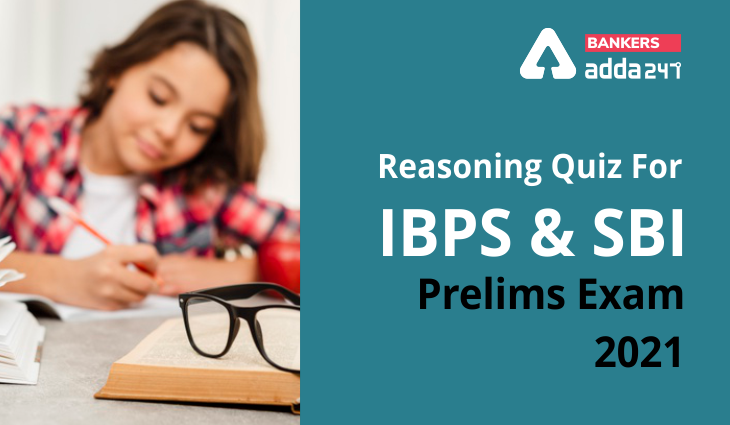Directions (1-5): Study the following information carefully and answer the question given below-
Seven friends i.e. G, R, D, O, X, P and Z have seated around a circular table. Some are facing towards centre and some are facing outside. They have different branded laptop i.e. Sony, Lenovo, Dell, HP, Apple, Toshiba and Compaq. O faces the same direction as R. The one who has Toshiba laptop sits immediate left to X who does not face inside. P sits 2nd right of R. G sits 3rd right of X who has Apple. G has Sony laptop. Z sits 2nd left of the one who has Sony laptop. The one who has Sony laptop faces outside. D sits 2nd left of P who has HP laptop. D does not have Toshiba laptop. The one who likes Compaq sits immediate right of R. The one who has Dell is an immediate neighbor of X and sits immediate right of the one who has Lenovo. X faces the same direction as Z faces.
Q1. Who among the following sits immediate right of the one who has Dell?
(a) R
(b) O
(c) G
(d) Z
(e) D
Q2. How many friends sit between D and O, when counted from right of O?
(a) One
(b) Two
(c) Three
(d) Four
(e) None of these
Q3. Who among the following has Dell laptop?
(a) R
(b) O
(c) X
(d) Z
(e) D
Q4. Who among the following sits 2nd left of the one who has Dell?
(a) R
(b) O
(c) X
(d) Z
(e) D
Q5. D has which branded laptop?
(a) Lenovo
(b) Sony
(c) Dell
(d) Toshiba
(e) None of these
Direction (6-10): Study the following information carefully and answer the given questions.
There are nine members in three generation family i.e. J, T, U, C, M, Q, E, S, and G. Among them there are 3 married couples and only four females. J is paternal uncle of Q. U has only 2 children. S is daughter-in-law of M and M is son-in-law of T. C is married to M. E and G are sons of C. E is not married. T is father in law of S’s father-in-law. T is married to U.
Q6. Who among the following person is father of Q?
(a) T
(b) U
(c) G
(d) S
(e) M
Q7. How is G related to T?
(a) Grandson
(b) Daughter
(c) Daughter in law
(d) Sister
(e) None of these
Q8. Which of the following is true about U?
(a) U is aunt of Q
(b) M is daughter of U
(c) J is sister of U
(d) S is grandson of U
(e) None of true
Q9. How S is related to son in law of T?
(a) Father
(b) Daughter in law
(c) Son
(d) Sister in law
(e) Wife
Q10. How M’s sister in law is related to J?
(a) Son in law
(b) Nephew
(c) Niece
(d) Daughter in law
(e) Sister in law
Directions (11-15): In each of the questions below is given three statements followed by two conclusions numbered I and II. You have to take the given statements to be true even if they seem to be at variance with commonly known facts. Read all the conclusions and then decide which of the given conclusions logically follows from the given statements disregarding commonly known facts.
Q11. Statements:
No day is night.
All night is bright.
All bright are star.
Conclusions:
I. All day being bright is a possibility.
II. Some star is not day.
(a) None follows
(b) Only I follows
(c) Only II follows
(d) Either I or II follow
(e) Both I and II follow
Q12. Statements:
Some steel is cup.
All steel is metal.
Some metal is iron.
Conclusions:
I. All cup is iron.
II. Some iron is not cup.
(a) None follows
(b) Only I follows
(c) Only II follows
(d) Either I or II follow
(e) Both I and II follow
Q13. Statements:
Some gold is iron.
Only a few iron is silver.
No silver is black.
Conclusions:
I. Some gold is black.
II. All Black is Iron is a possibility
(a) None follows
(b) Only I follows
(c) Only II follows
(d) Either I or II follow
(e) Both I and II follow
Q14. Statements:
Some red is green.
All blue is pink.
No green is blue.
Conclusions:
I. Some Red is Pink is a possibility
II. No Blue is Red.
(a) None follows
(b) Only I follows
(c) Only II follows
(d) Either I or II follow
(e) Both I and II follow
Q15.Statements:
Some bird is animal.
No animal is wild
Some wild is lion.
Conclusions:
I. Some bird is lion.
II. No lion is bird.
(a) None follows
(b) Only I follows
(c) Only II follows
(d) Either I or II follow
(e) Both I and II follow
Practice More Questions of Reasoning for Competitive Exams:
Reasoning for Competitive Exams |
Reasoning Ability Quiz For SBI, IBPS Prelims 2021- 5th April |
Reasoning Ability Quiz For SBI, IBPS Prelims 2021- 4th April |
Study Plan for IBPS and SBI Exams 2021 |
Solutions
Solutions (1-5):

S1. Ans.(e)
S2. Ans.(b)
S3. Ans.(d)
S4. Ans.(a)
S5. Ans.(a)
Solutions (6-10):

S6.Ans(a)
S7.Ans(a)
S8.Ans(e)
S9.Ans(b)
S10.Ans(c)
Solutions (11-15):
S11. Ans(e)
Sol.

S12. Ans(a)
Sol.

S13. Ans(c)
Sol.

S14. Ans(b)
Sol.

S15. Ans(d)
Sol.

Practice with Online Test Series for SBI and IBPS Prelims 2021:
Click Here to Register for Bank Exams 2020 Preparation Material




 GA Capsule for SBI Clerk Mains 2025, Dow...
GA Capsule for SBI Clerk Mains 2025, Dow...
 The Hindu Review October 2022: Download ...
The Hindu Review October 2022: Download ...
 IBPS PO Apply Online 2025, Online Applic...
IBPS PO Apply Online 2025, Online Applic...


